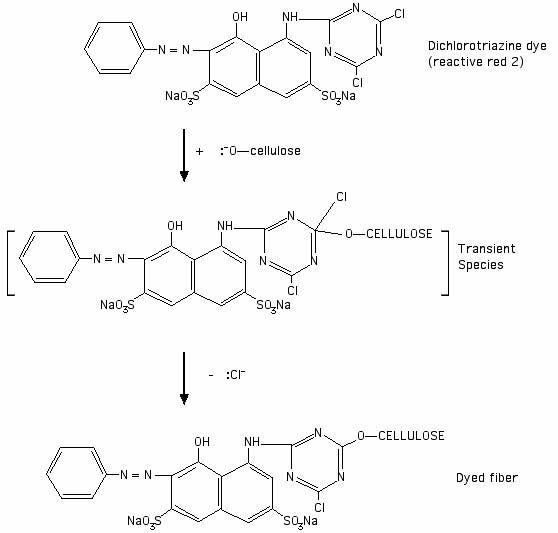chemical reaction for a dichlorotriazine dye with cellulose
Message: I am a chemistry student doing a project on the chemistry of tie-dying. I understand parts of the reaction, like how the cellulose loses hydrogen atoms and the dye molecules lose the chlorine atoms because of your website. But I am not sure how to formalize it into a chemical equation. Could you possibly give me the equation, using one of the dyes, like the blue MX-R or red MX-8B found on your webpage? If you have time, I would really appreciate it. Thank you,
This is from Chapter 4 in the book Cellulosics Dyeing. The book was edited by John Shore, and the chapter was written by him; see my page of 'Books and Videos on Hand Dyeing and Fabric Painting'....
"[Reactive dyes] based on nitrogen-containing heterocyclic rings bearing halogeno substituents undergo nucleophilic substitution. The heteroatoms in the aryl ring activate the system for nucleophilic attack because of their electronegativity. The attacking neutrophile can be either a cellulosate anion or a hydroxide ion, the former leading to fixation on the fibre and the latter resulting in hydrolysis of the reactive dye."
I drew the following illustration of the reaction of reactive red 2 (Procion MX red-5B) with a cellulosate anion, based on an illustration of a generic dichlorotriazine reaction in Cellulosics Dyeing:

Posted: Thursday - May 19, 2005 at 08:56 PM All About Hand Dyeing Q&A Previous Next
Follow this blog on twitter here.
- Top of this blog -
- FAQ -
- The Dye Forum -
- How to Tie Dye - How to Batik -
- Books - Toys - Plants -
More in this category:
- -
Follow this blog on twitter here.
Calendar
Search
Categories
- about dyes
- batik
- big projects
- business of dyeing
- changing color of clothing
- chemistry of dyeing
- color mixing
- disasters and problems
- discharge (bleach) dyeing
- dye & fiber choice
- dye application
- dye safety
- dyeing acrylic
- dyeing furniture
- dyeing nylon
- dyeing objects
- dyeing polyester
- finding a dyer
- fixing dye
- immersion or vat dyeing
- miscellaneous
- natural dyes
- pigments and fabric paint
- rainbow dyeing
- removing dye
- satin can be any fiber
- schoolwork
- screen prints & dye
- they want to sell us dyes
- tie dye parties
- tie-dyeing, resists, shibori
- washing out after dyeing
- where to get dyes and supplies
Archives
XML/RSS Feed
Statistics
All About Hand Dyeing Q&A: 2223
about dyes: 176
batik: 57
big projects: 12
business of dyeing: 8
changing color of clothing: 357
chemistry of dyeing: 105
color mixing: 53
disasters and problems: 68
discharge (bleach) dyeing : 32
dye & fiber choice: 209
dye application: 72
dye safety: 49
dyeing acrylic: 2
dyeing furniture: 49
dyeing nylon: 46
dyeing objects: 33
dyeing polyester: 125
finding a dyer: 50
fixing dye: 106
immersion or vat dyeing: 20
miscellaneous: 127
natural dyes: 30
pigments and fabric paint: 48
rainbow dyeing: 11
removing dye: 63
satin can be any fiber: 9
schoolwork: 43
screen prints & dye: 12
they want to sell us dyes: 2
tie dye parties: 23
tie-dyeing, resists, shibori: 56
washing out after dyeing: 32
where to get dyes and supplies: 133
– ADVERTISEMENTS –
Tie-dye kits make great gifts!
Total entries in this category:
Published On: Aug 29, 2012 02:48 PM
 Syndicate this site
Syndicate this site